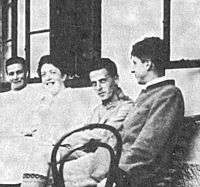Remarks on Colour
| Part of a series on |
| Ludwig Wittgenstein |
|---|
 Wittgenstein (second from right), Summer 1920 |
|
Works |
|
Interpreters
|
Remarks on Colour (German: Bemerkungen über die Farben) was one of Ludwig Wittgenstein's last works, written during a visit to Vienna in 1950 while dying of cancer.[1] Believing that philosophical puzzles about colour can only be resolved through attention to the involved language-games, he considers Goethe's propositions in the Theory of Colours, and the observations of Philipp Otto Runge in an attempt to clarify the use of language about colour.[2]
| “ | Goethe's theory of the constitution of colours of the spectrum has not proved to be an unsatisfactory theory, rather it really isn't a theory at all. Nothing can be predicted with it. It is, rather a vague schematic outline of the sort we find in James's psychology. Nor is there any experimentum crucis which could decide for or against the theory. Someone who agrees with Goethe believes that Goethe correctly recognized the nature of colour. And nature here is not what results from experiments, but it lies in the concept of colour.[3] | ” |
Wittgenstein was interested in the fact that some propositions about colour are apparently neither empirical nor exactly a priori, but something in between: phenomenology, according to Goethe. However, he took the line that 'There is no such thing as phenomenology, though there are phenomenological problems.' He was content to regard Goethe's observations as a kind of logic or geometry. Wittgenstein took his examples from the Runge letter included in the "Farbenlehre", e.g. "White is the lightest colour", "There cannot be a transparent white", "There cannot be a reddish green", and so on. The logical status of these propositions in Wittgenstein's investigation, including their relation to physics, was discussed in Jonathan Westphal's Colour: a Philosophical Introduction (1991).
| “ | There seem to be propositions that have the character of experiential propositions, but whose truth is for me unassailable.. There are, in any case, errors.. which must be set apart from the rest of my judgements as temporary confusions. But aren't there transitional cases between these two. If we introduce the concept of knowing into this investigation, it will be of no help; because knowing is not a psychological state whose special characteristics explain all kinds of things. On the contrary, the special logic of the concept 'knowing' is not that of a psychological state. (Wittgenstein, pp. III.348-350) | ” |
Although Remarks on Colour is considered difficult on account of its fragmentation,[2] his last work, On Certainty (German: Über Gewissheit) is considered to be his most lucid.
References
- ↑ "Weaving the Rainbow: Visions of Color in World History" by Robert Finlay, University of Arkansas, at warwick.ac.uk
- 1 2 McGinn, M. (October 1991). "Wittgenstein's Remarks on Colour". Philosophy. 66 (258): 435–453. doi:10.1017/S0031819100065104. JSTOR 3751218.
- ↑ Wittgenstein, Ludwig (1977). G. E. M. Anscombe, ed. Remarks on Colour. University of California Press. pp. 70–71.